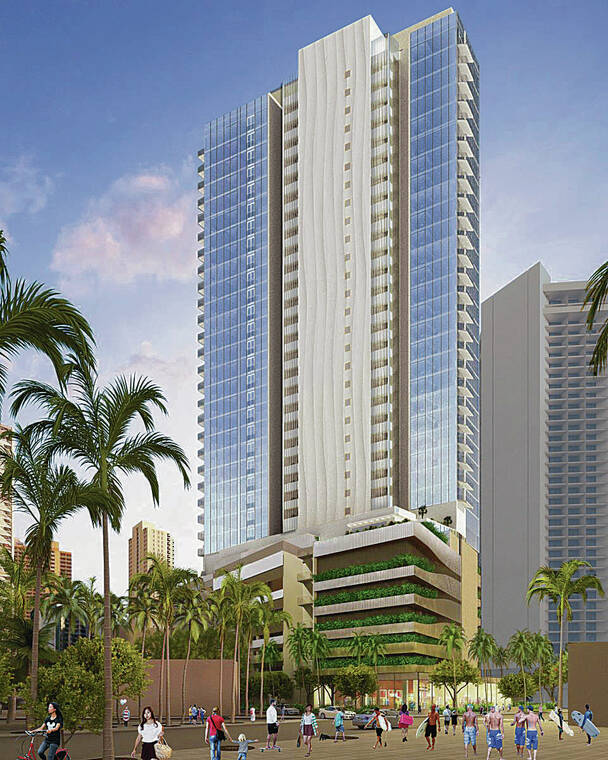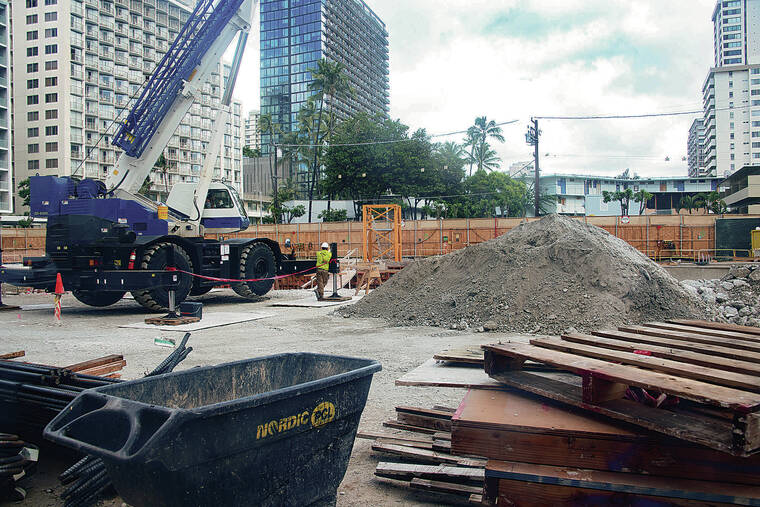Construction on the Ka Haku by Hilton Club, a 32-story timeshare tower in the heart of Waikiki at the former King’s Village site, has started again after a lengthy COVID-19 hiatus.
Hilton Grand Vacations has been pursuing the project since 2018 when it purchased a 1.05-acre site from BSC KVSC LLC that included the Hale Waikiki Apartments and Prince Edward Apartments parcels as well as King’s Village, a circa-1970s Waikiki landmark patterned after Disneyland’s Main Street USA.
Kelly Olinger, HGV’s
senior vice president of development, told the Honolulu Star-Advertiser that new plans for Ka Haku anticipate sales will begin in the later part of this year and that the project will be completed in mid-2026.
During the pause, Olinger said HGV “used the gift of time” to work with its design team to enhance the project. Olinger said the exterior remains unchanged, but the project’s unit count was increased to 205 units from 191 units ranging in size from studios to one-, two- and three-bedroom units. The project will have 185 parking stalls across six floors and will welcome guests on its seventh-floor amenity deck.
Olinger said there also will be two ground-floor retail spaces, which are owned by the parties who sold the parcels to HGV. BSC KVSC LLC is a partnership that includes BlackSand Capital, a real estate private equity firm focused solely on Hawaii real
estate, The MacNaughton Group, Kobayashi Group and others.
It was back in 2019 that HGV demolished King’s
Village to make way for
the new timeshare tower, which was anticipated to be completed toward the end of 2021. However, COVID-19 and the subsequent tourism downturn hit, causing a 3-1/2-year hiatus.
“As with so many of the things that happened in 2020, we ended up having to shut the project down. We weren’t able to staff it,” Olinger said. “It took us a while to see the rebound in the business that we needed to support restarting a project. We finally reached that point in the middle of (2023) where things were lining up and it felt like it was time to start the project up again.”
He added that the sluggish return of the Japan market after COVID-19 also delayed development of the project.
“Amongst HGV’s over 525,000 owners, over 70,000 of those are Japanese, and most of those owners own on Oahu and in Japan,” Olinger said. “So the Japanese business is a big part of what we do,” but he added that he expected the timing would be right by the time the project was delivered.
Megumi Haubner, HGV director of corporate communications, said that in recent years HGV has seen good recovery of the Japan market. Haubner said 25% of the visitors from Japan who came to Oahu in 2022 were owners or guests at HGV properties, and the number was almost 50% on Hawaii island. She said heading into the end of 2023, 17% of the visitors from Japan who came to Oahu in 2023 were owners or guests at HGV properties, and the number was 41% on Hawaii island.
“Our recovery has been particularly strong for the Japanese market,” Haubner said. “Ka Haku is going to be very popular with the Japanese market.”
As part of the project entitlements, Kaiulani Avenue will become a two-way road from Kalakaua to Koa avenues. Community givebacks are expected to include development of a pocket park on Prince Edwards Street that will be open to the public, and a $1 million fund for community benefits that will be determined by the Honolulu City Council.
“We want to be great neighbors. We’ve been in constant communication with the neighborhood, the association, and we are working hard to make this go as smoothly as possible,” Olinger said. “This will be our 14th resort in Hawaii and our seventh on Oahu.”
The project, which will be HGV’s first on Oahu since the 2017 opening of The Grand Islander by Hilton Grand Vacations Club, will bring HGV’s unit count on Oahu to 1,800.
Haubner said some 400 jobs will be created during Ka Haku’s construction phase. She said the completed tower is expected to have up to 120 resort operations team members and some 60 sales and marketing employees.
Fans of the project say it grows Hawaii’s timeshare market, which is noted for delivering higher-spending, resilient tourists. It also will continue gentrifying the back half of Waikiki. Critics of the project have said that tourism and high-rise density are out of control in Waikiki.
Waikiki Neighborhood Board member Jeff Merz said the board has been receptive to HGV’s tower plans, which received little pushback from the Waikiki community when they were first presented to the board and again during a November update.
“There was the usual discussion about density and views, but no one really objected to removing King’s Village,” he said. “That land is zoned for this type of use.”
Merz said the board will monitor HGV to ensure that it keeps to the plans and community benefits that it presented to the community.
“When we review the building permits, we’ll make sure that these plans were completed before they get their occupancy permit,” Merz said.
He added that it’s good to see the project moving forward, as “it activates that corner and will generate more foot traffic and more revenue.”




